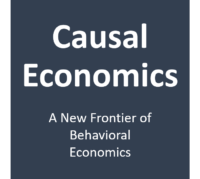Use Based Taxation – Is it Time for a Test?
By Andrew Horton, March 2022
In most economies, just as certain as death and taxes is the approach of collecting taxes every time certain economic activities occur such as earning or spending and or whenever assets such as property are held or bought and sold. These funds generally go into government coffers and governments allocate them to spending. It’s an approach that can be thought of as source based taxation—taxes are collected automatically, separate of any defined program requirements, and then funds are allocated by a representative government.
In this brief article we consider use based taxation for some well-defined programs. Use based taxation reverses the flow, starting with broadly costed programs that governments get approved through direct democratic vote, which are then funded through a directly applied tax. Use based taxes are an application of Causal Economic theory, which we’ll cover more below.
Causal Economics
Causal economics is a stream of economics that centers on the principle of causal coupling. Causal coupling models decisions as requiring upfront cost and effort in anticipation of future anticipated benefits—like the real world. This is very different from other mainstream decision models that unrealistically either assume complete rationality or allow for irrationality but characterize decisions as single period random outcomes. Causal coupling also implies that societal policies will be fair and sustainable to the extent that they couple cost and benefit across all stakeholders. It means that people are free and accountable. Essentially, citizens reap the rewards of their contribution, contribute effort in order to benefit and pool significant risks to protect each other from catastrophic outcomes.
Potential Benefits of Use Based Taxation
There are a number of potential benefits to use based taxation:
- More efficient government spending. Governments have to make a specific case to voters for the funds they want to collect. Coffers aren’t just automatically filled and then spent in order to ‘justify’ the need for the source taxes.
- Spending programs are tied directly to the desires of the democratic majority, not the preferences of career politicians within representative government.
- Fairer allocation of the tax bill across those that benefit from the program services while still providing support for those unable to carry their proportionate share of the cost.
More Efficient Government Spending
When government coffers aren’t automatically filled every time citizens conduct private affairs like earning income and consuming, the government has to get specific about what they want money for and then make a ‘business case’ before they get the funding. The implication of this flow reversal would be to shift focus from poorly planned programs to ones that are well-defined with significant expected benefits relative to costs. There should be less of the former and more of the latter that receive funds.
Directly Align to Desires of Democratic Majority
Direct program voting allows specific definition of a program by voters, beyond the general vote of confidence inherent in entrusting representative politicians to interpret voter needs on each issue. In representative democracy, career politicians are generally held accountable to the people through regular elections. This provides a base level of accountability to the voter, but it provides nowhere near as much performance and financial accountability as citizens voting directly on specific issues, tying spend requirements to funding sources. In addition to accountability,
Fairer Allocation of Tax Costs
Use based taxes follow the principle of causal coupling, which from an economic perspective allocates the core costs of a program via flat tax and/or user fee across those that will benefit from the program services. Where all citizens benefit, they will each contribute a flat proportionate share of the cost, and where beneficiaries are identifiable (like users of a toll bridge) a user fee will best match cost and benefit. Where citizens are willing but unable to bear their prorated share of cost, the democratic majority can opt to provide tax relief by transferring some or all of the share of costs of those unable to pay in full, to other citizens that pay on their behalf.
Key Insights
The size of government and the related tax and spend infrastructures are significant in today’s complex economies. Taking note of the principle of causal coupling in causal economics isn’t likely to result in a wholesale shift in our current world, but can be a guide for future, well defined programs. However, there is no reason that representative governments can’t table some specific high impact programs for direct vote, with an associated plan of where spend is to occur and funding is to be sourced. With causal economics and causal coupling in mind, those citizens that believe in the principles of maximum freedom with associated accountability have a tangible tool by which to push their governments for greater accountability. It’s certainly something worth testing to measure results.
